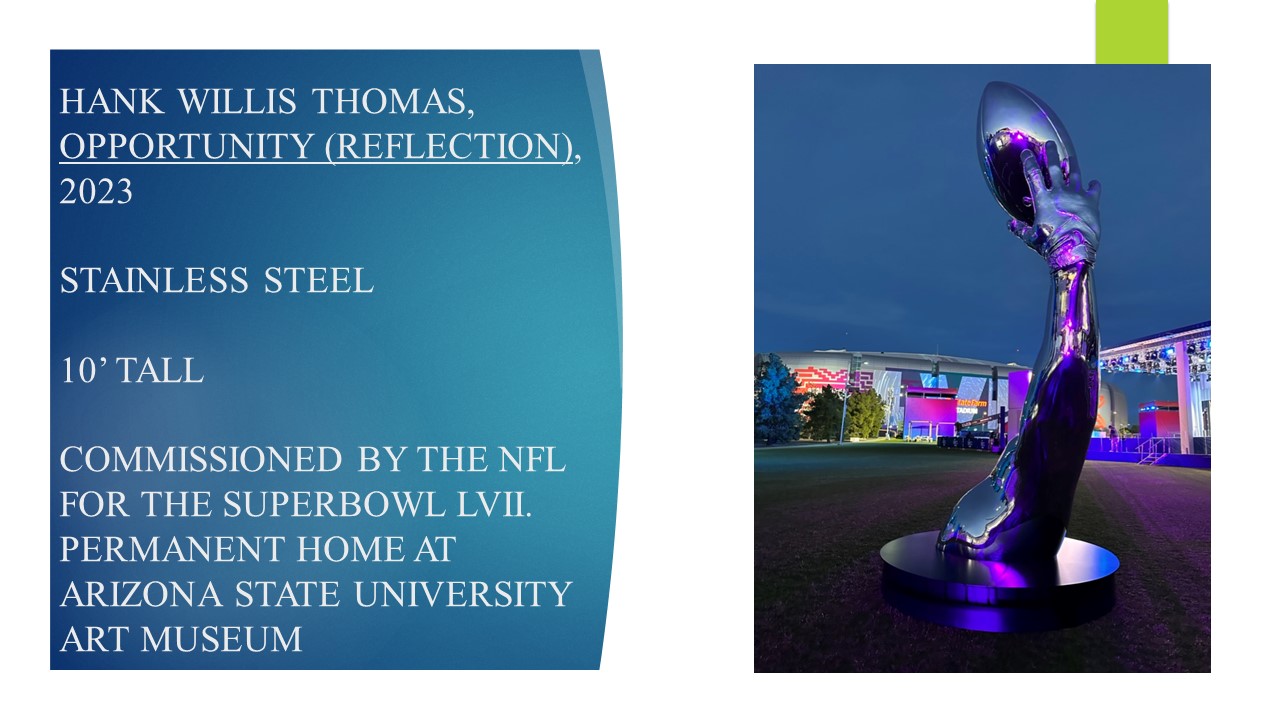Hank Willis Thomas
Upon entering the room filled with conceptual photography, sculpture, mixed media, text-based pieces, and installations, the audience is overwhelmed by Hank Willis Thomas’ view of identity, race, and class. There is an innate sense of belief that race and class only exist in the fabrication of our minds. His proof is refreshing and convincing; his work is commentary and open-ended. As Thomas has advised, “The role of an artist is to work in society’s subconscious.” One of his mediums, photography, is the perfect vehicle to focus on the chosen feature through cropping. This level of hyper-focus helps us to realize how our subjectivity colors what we are thinking. Scarred Chest evokes images of scarification and branding. Native Africans often used scars for beautification, scars made slaves less valuable, and corporate branding is an advertising ploy attaching chosen athletes to specific products. This form of commodification shapes our notion of ourselves and the value of other people at the same time.
The enslavement of an entire race dehumanized people for control. This dehumanization allows the word “race” to exist, causing thousands of years of existence to be reduced to a single identity. The Cotton Bowl makes us ponder all the possibilities of the infinite meaning of race, sports, and commodification while seeing the black athlete as spectacle and souvenir. This photograph allows us to see the visual parallel of indentured servants to the role of college male athletes. Just as the fieldworker toiled for rent from his landlord, the athlete works for education at his university. In neither case is labor taken out of their owners’ profits.
When we consider art to be a complex web of meanings and relationships, like the works of Thomas, we realize that art can affect the viewer in innumerable ways. Successful art is art that has found its way into the minds of audiences—adding to the richness and depth of the subject. This is what every successful artist seeks. The artist is not directing you to think in a certain way but is asking the viewer to think.
His work holds an underlying essence, a fundamental structure—the life-giving feature that makes it what it is. It is the concept, the cropping, the photographer’s viewpoint, and the material chosen that makes his sculptures like The Embrace monumental. This public art depicts a ceremonial hug between Martin Luther and Coretta Scott King after he won the 1964 Nobel Peace Prize. This Prize represented the beginning of important changes in the American societal truth concerning race—opening communities and dialogs. It represents the King’s vision of a more loving and just society. Through experimentation and playing, Thomas distills his work down to its very essence and yet releases the least amount of information. As Antoine de Saint-Exupéry wrote in Terre des Hommes, “Perfection is achieved, not when there is nothing more to add, but when there is nothing left to take away.”
In a conversation between Hank Willis Thomas and Artnews,
“… Willis Thomas quoted James Baldwin saying, ‘Artists are the legislators of possibility and the parliamentarians of hope’. To which Willis Thomas added, ‘Artists are the gatekeepers of truth, we’re civilization’s radical voice’. Thomas goes on to say that civil leaders should think more like creators and artists, especially when it comes to confronting social justice issues that have permeated throughout the United States for centuries, ‘because if we are dealing with centuries old problems in century old ways, if we really want to transcend, we’re going to take action.”
More of Thomas’ philosophy and background can be seen at Art 21.
See more of Thomas’ work at his website or at Jack Shainman Gallery, Goodman Gallery, Maruani Mercier, and Pace Gallery.
PLEASE SEE PORTFOLIO BELOW















